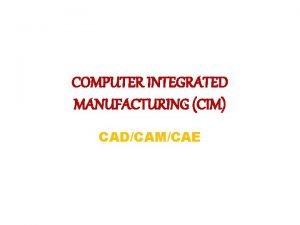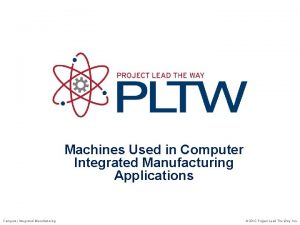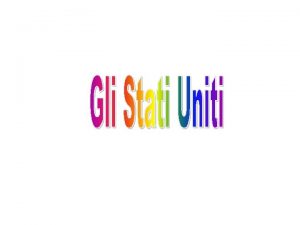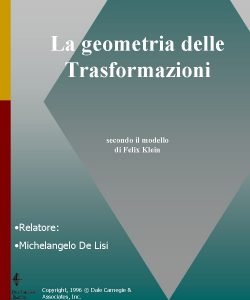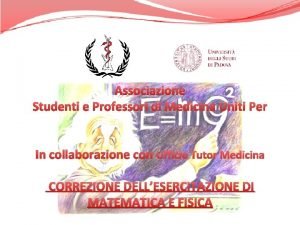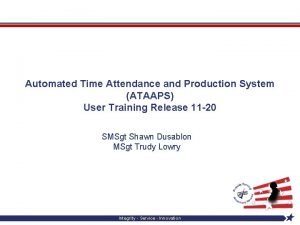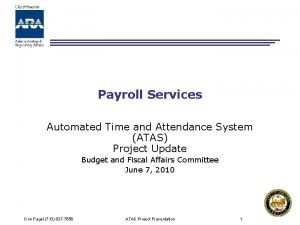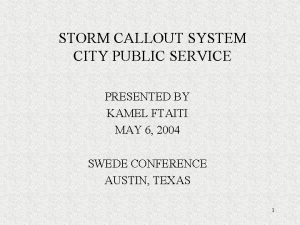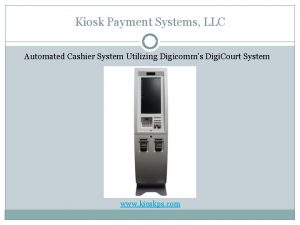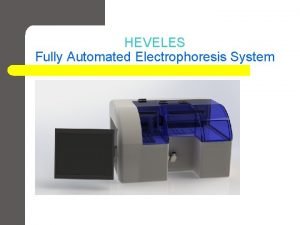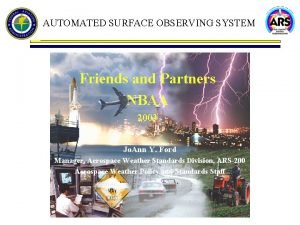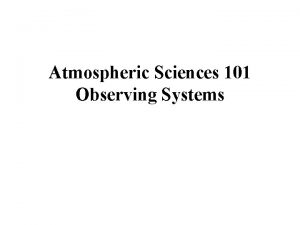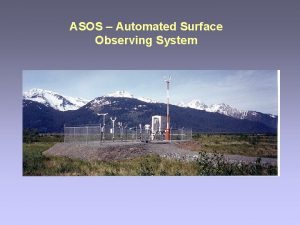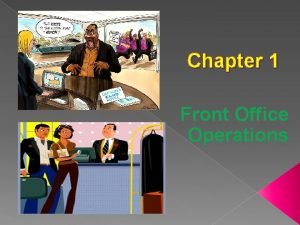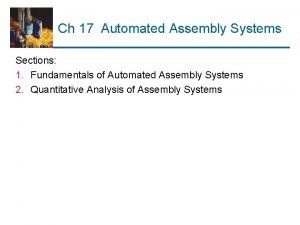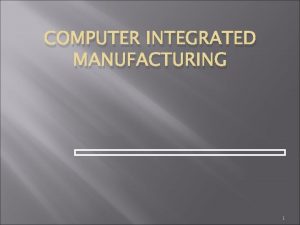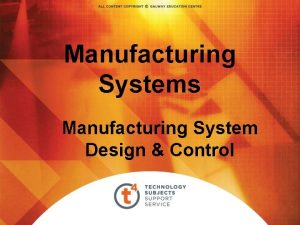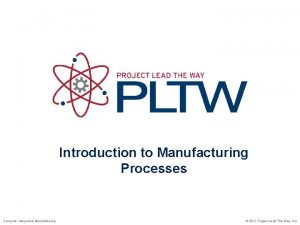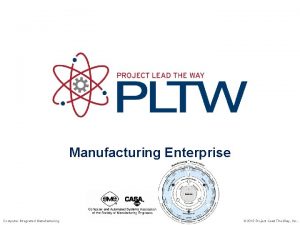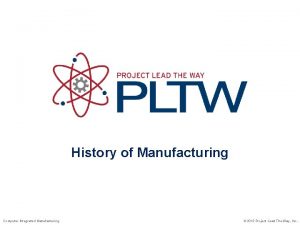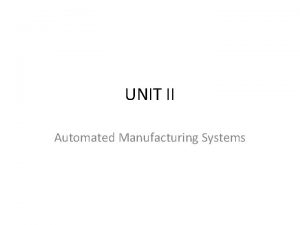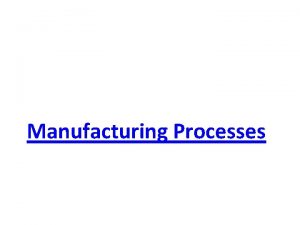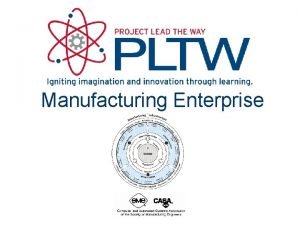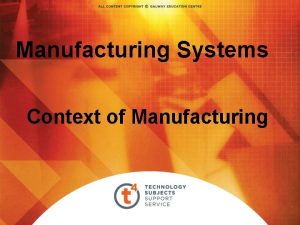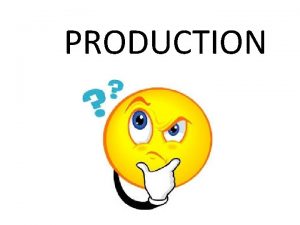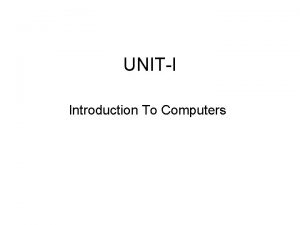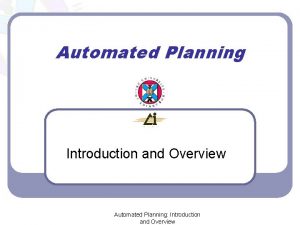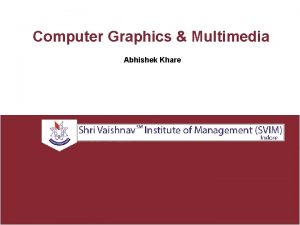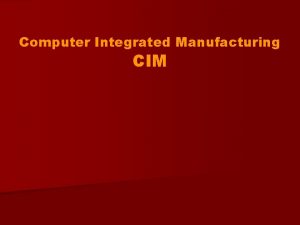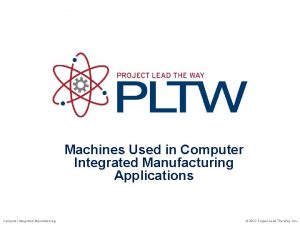Automated and Computer Integrated Manufacturing System UNITI Introduction
























- Slides: 24

Automated and Computer Integrated Manufacturing System

UNIT-I Introduction • Computer-aided design (CAD) is the use of computer systems to assist in the creation, modification, analysis, or optimization of a design. • Computer-aided manufacturing (CAM) is the use of computer systems to plan, manage, and control the operations of a manufacturing plant through direct or indirect computer interface with plant’s resources. • Computer-integrated manufacturing (CIM) is the manufacturing approach of using computers to control the entire production process. This integration allows individual processes to exchange information with each other and initiate actions. Through the integration of computers, manufacturing can be faster and less error-prone, although the main advantage is the ability to create automated manufacturing processes. Typically CIM relies on closedloop control processes, based on real-time input from sensors. It is also known as flexible design and manufacturing 3/10/2021 revotechnologies. net

Need for CAD/CAM • To increase productivity of the designer • To improve quality of the design • To improve communications • To create a manufacturing database • To create and test tool paths and optimize them • To help in production scheduling and MRP models • To have effective shop floor control 3/10/2021 revotechnologies. net

Design Process Before CAD 3/10/2021 After CAD revotechnologies. net

Evolution of CIM 1970 s - 1980 s…Flexible Manufacturing • Systems/Cells • • “… a group of CNC machinery/equipment linked by • an automated materials handling system, whose • operation is integrated by supervisory computer • control …” • • Provided efficient mid-volume, mid-variety • production • • Increased machine utilization • • Reduced work-in-process inventory, labor and • tooling costs, setup costs, lead time, lot size • • Ability to react quickly to engineering changes 3/10/2021 revotechnologies. net

• • • 1980 s. . . Computer Integrated Manufacturing • “… computer assisted control and integration at all levels of a manufacturing enterprise …” • Strict hierarchical information flow • Totally automated, unmanned, paperless factory • Integration problems in heterogeneousm environments 3/10/2021 revotechnologies. net

• • • 1990 s…Intelligent Manufacturing • “… architecture for highly decentralized manufacturing systems, built from a modular mix of autonomous, cooperative, and intelligent elements (agents) …” • Re-emergence of the human factor seeking to maximize the use of human intellectual skills and flexibility • Migrating from hierarchy to Vertically • Capability of rapid self-reconfiguration by incorporating human and machine intelligence 3/10/2021 revotechnologies. net

Definition of CIM • Computer Integrated Manufacturing is the integration of the total manufacturing enterprise through the use of integrated systems and data communications coupled with new managerial philosophies that improve organizational and personnel efficiency. 3/10/2021 revotechnologies. net

CIM Wheel 3/10/2021 revotechnologies. net

Production concept Types of Production 1. Job shop production 2. Batch production 3. Mass production 3/10/2021 revotechnologies. net

1. Job shop production. • The distinguishing feature of job shop production is low volume. The manufacturing lot sizes are small, often one of a kind. Job shop production is commonly used to meet specific customer orders, and there is a great variety in the type of work the plant must do. Therefore, the production equipment must be flexible and generalpurpose to allow for this variety of work. Also, the skill level of job shop workers must be relatively high so that they can perform a range of different work assignments. • Examples of products manufactured in a job shop include space vehicles, aircraft, machine tools, special tools and equipment, and prototypes of future products. • Construction work and shipbuilding are not normally identified with the job shop category, even though the quantities are in the appropriate range. Although these two activities involve the transformation of raw materials into finished products, the work is not performed in a factory. 3/10/2021 revotechnologies. net

2. Batch production: This category involves the manufacture of medium-sized lots of the same item or product. The lots may be produced only once, or they may be produced at regular intervals. The purpose of batch production is often to satisfy continuous customer demand for an item. However, the plant is capable of a production rate that exceeds the demand rate. Therefore, the shop produces to build up an inventory of the item. Then it changes over to other orders. When the stock of the first item becomes depleted, production is repeated to build up the inventory again. The manufacturing equipment used in batch production is general-purpose but designed for higher rates of production. Examples of items made in batch-type shops include industrial equipment, furniture, textbooks, and component parts for many assembled consumer products (household appliances, lawn mowers, etc. ). Batch production plants include machine shops, casting foundries, plastic molding factories, and press working shops. Some types of chemical plants are also in this general category. 3/10/2021 revotechnologies. net

3. Mass production: • This is the continuous specialized manufacture of identical products. Mass production is characterized by very high production rates, equipment that is completely dedicated to the manufacture of a particular product, and very high demand rates for the product. Not only is the equipment dedicated to one product, but the entire plant is often designed for the exclusive purpose of producing the particular product. The equipment is special-purpose rather than general-purpose. The investment in machines and specialized tooling is high. In a sense, the production skill has been transferred from the operator to the machine. Consequently, the skill level of labor in a mass production plant tends to be lower than in a batch plant or job shop. 3/10/2021 revotechnologies. net

Functions in Manufacturing 1. Processing 2. Assembly 3. Material handling and storage 4. Inspection and test 5. Control 3/10/2021 revotechnologies. net

CIM Hardware and Software CIM Hardware comprises the following: i. Manufacturing equipment such as CNC machines or computerized work centers, robotic work cells, DNC/FMS systems, work handling and tool handling devices, storage devices, sensors, shop floor data collection devices, inspection machines etc. ii. Computers, controllers, CAD/CAM systems, workstations / terminals, data entry terminals, bar code readers, RFID tags, printers, plotters and other peripheral devices, modems, cables, connectors etc. 3/10/2021 revotechnologies. net

CIM software comprises computer programmes to carry out the following functions: • Management Information System • Sales • Marketing • Finance • Database Management • Modeling and Design • Analysis • Simulation • Communications • Monitoring • Production Control • Manufacturing Area Control • Job Tracking • Inventory Control 3/10/2021 • Shop Floor Data Collection • Order Entry • Materials Handling • Device Drivers • Process Planning • Manufacturing Facilities Planning • Work Flow Automation • Business Process Engineering • Network Management • Quality Management revotechnologies. net

Elements of CIM 3/10/2021 revotechnologies. net

The Future Automated Factory The concept of the automated factory is usually applied in the context of discrete product manufacturing and in connection with products that are made in medium or small batch sizes. The factory of the future will have to perform basic manufacturing functions such as processing, assembly, material handling and storage, inspection, and control. 3/10/2021 revotechnologies. net

The objective in the automated factory is to achieve a level of untended integrated operation similar to that which currently exists in a computer-controlled production plant which processes chemicals, petroleum, foods, and certain metals. In such a plant, there exists a relatively small crew of perhaps 5 or 10 persons who observe the production operations. These people perform maintenance and repair functions on the equipment, programming of the computer systems, monitoring the computer controlled processes, activities that involve interactions with the outside world, plant security, and general supervision. 3/10/2021 revotechnologies. net

1. The Information System in the Automated Factory Information system of the future will probably have the capacity to interpret data in more than the conventional data processing sense. Instead of merely performing repetitive calculations on the data, the system will be able to understand the inherent meaning of the data being manipulated. Large computer systems at the third and fourth levels of the computer hierarchy will possess attributes of comprehension and intelligence in their processing of information. They will be able to make decisions and initiate actions in the company for the timely execution of procedures that must occur during the manufacturing cycles. In essence, the information system used to support the automated factory of the future will become a “knowledge base management system” rather than a data base management system. 3/10/2021 revotechnologies. net

2. Processing and Assembly The processing and assembly functions in manufacturing are the fundamental operations that transform raw materials and add value to them. Let us consider some of the changes that are likely to occur in processing and assembly technology. 3/10/2021 revotechnologies. net

3. Material Handling The material handling function looms as a significant obstacle that must be overcome if we are to achieve the future in small- and medium-lot-size manufacturing. Two problem areas regarding material handling will be : • Flexible routing for different parts, and • Mechanical interfacing of material handling and production systems. 3/10/2021 revotechnologies. net

4. Inspection Systems The inspection function is to become more automated in the future as quality continues to remain a high-priority issue. Current trends in automated inspection suggest that the future factory will be characterized in the quality control area by following : • Inspection procedures will be integrated into the production process to form a closed loop feedback control system. Processing errors detected in inspection will be corrected on line so that much closer to 100% good product can be achieved. • Automated inspection methods will permits the use of 100% inspection of production output rather than the sampling inspection procedures. • Noncontact sensors, such as machine vision and other optical techniques, will come into widespread use in automated inspection. • Computer-controlled inspection technologies that can be adapted to varying product configurations will grow in importance in the future automated factory. 3/10/2021 revotechnologies. net

Impact of CIM 1. Impact on labours 2. Retraining and Education 3. Social and Economic forces 3/10/2021 revotechnologies. net
 Cim wheel
Cim wheel Computer integrated manufacturing applications
Computer integrated manufacturing applications Manufacturing cost vs non manufacturing cost
Manufacturing cost vs non manufacturing cost Manufacturing cost vs non manufacturing cost
Manufacturing cost vs non manufacturing cost Commited cost
Commited cost Manufacturing cost vs non manufacturing cost
Manufacturing cost vs non manufacturing cost Additive manufacturing steps
Additive manufacturing steps Settore primario stati uniti
Settore primario stati uniti Composizione di omotetie
Composizione di omotetie Studenti e professori uniti per
Studenti e professori uniti per Uniti in templul tau sfant versuri
Uniti in templul tau sfant versuri Ataaps
Ataaps Automated time and attendance payroll system
Automated time and attendance payroll system 3 components of computer system
3 components of computer system Difference between a computer and computer system
Difference between a computer and computer system Integrated and differentiated services in computer networks
Integrated and differentiated services in computer networks Rostermonster arcos
Rostermonster arcos Automated payment kiosk
Automated payment kiosk Automated electrophoresis system
Automated electrophoresis system Automated surface observing system
Automated surface observing system Sr 71 star tracker
Sr 71 star tracker Automated surface observing system
Automated surface observing system Automated surface observing system asos
Automated surface observing system asos Reservation rack in front office
Reservation rack in front office Escapement and placement devices
Escapement and placement devices
